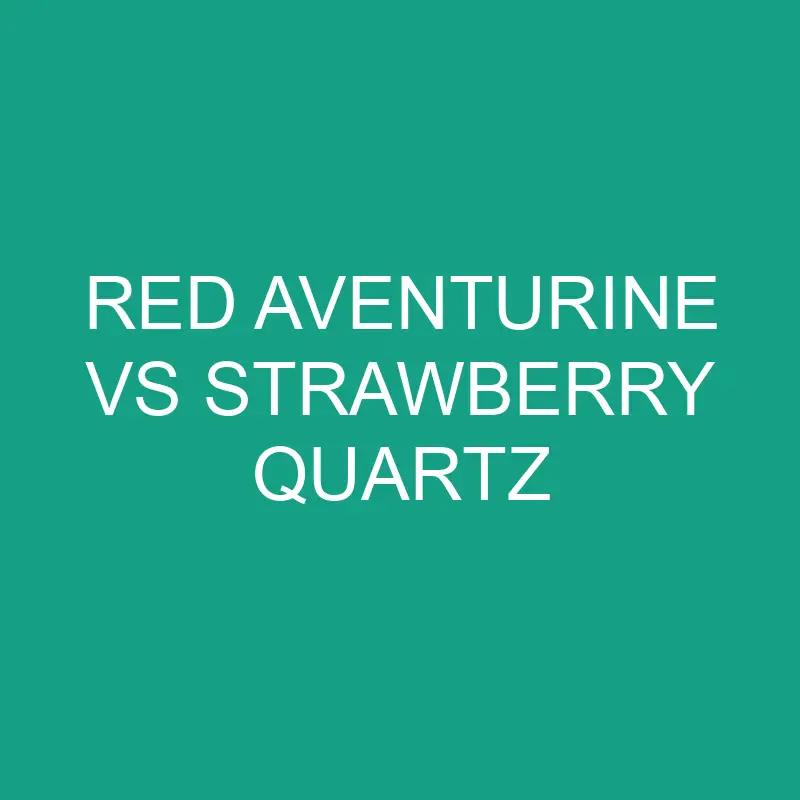Unveiling the Radiance of Unique Gemstones
In the kaleidoscope of gemstones, Red Aventurine and Strawberry Quartz stand out for their distinctive colors and captivating properties. Both stones, though unique in appearance, share a certain warmth and allure that make them popular choices in jewelry and crystal healing practices. In this exploration, we will delve into the individual characteristics, geological origins, metaphysical properties, and uses of Red Aventurine and Strawberry Quartz, unveiling the radiance within these unique gemstones.
Post Contents
Red Aventurine: The Stone of Vitality
Origins and Geological Background:
- Composition: Red Aventurine is a variety of quartz that contains tiny inclusions of minerals like hematite or goethite, giving it its reddish-brown hue.
- Color and Appearance: It exhibits a range of red shades, from rusty brown to deep red, often with sparkling metallic inclusions.
- Formation: The coloration is attributed to the presence of iron oxides and other minerals during the crystallization process.
- Locations: Red Aventurine is found in various parts of the world, including India, Brazil, and Russia.
Physical Properties:
- Hardness: Red Aventurine has a hardness of 7 on the Mohs scale, making it relatively durable and suitable for various jewelry applications.
- Texture: It often has a granular or sparkly texture due to the presence of mineral inclusions.
Metaphysical Properties:
- Vitality and Energy: Red Aventurine is associated with vitality, courage, and a zest for life. It is believed to boost physical energy and enhance motivation.
- Root Chakra Activation: It is often linked to the root chakra, fostering a sense of stability, grounding, and connection to the Earth.
Uses:
- Jewelry: Red Aventurine is used in various forms of jewelry, including beads, cabochons, and pendants. Its warm tones make it an attractive choice for accessories.
- Crystal Healing: In crystal healing practices, Red Aventurine is used to stimulate energy, enhance motivation, and support overall well-being.
Strawberry Quartz: The Gem of Love and Harmony
Origins and Geological Background:
- Composition: Strawberry Quartz is a variety of quartz that gets its delicate pink color from inclusions of iron oxide or goethite.
- Color and Appearance: It ranges in color from pale pink to a deeper, strawberry-like hue. It often has a translucent to transparent appearance.
- Formation: The coloration is a result of the presence of specific mineral inclusions during the quartz’s formation.
- Locations: Strawberry Quartz is found in locations such as Brazil, Russia, and the United States.
Physical Properties:
- Hardness: Like other varieties of quartz, Strawberry Quartz has a hardness of 7 on the Mohs scale.
- Texture: It typically has a smooth and glassy texture, and its color is a result of the presence of included minerals.
Metaphysical Properties:
- Love and Harmony: Strawberry Quartz is associated with love, compassion, and harmony. It is believed to radiate soothing and loving energies.
- Heart Chakra Activation: It is often linked to the heart chakra, promoting emotional balance and fostering a sense of love and connection.
Uses:
- Jewelry: Strawberry Quartz is popular in jewelry, especially in beadwork, necklaces, and bracelets. Its gentle pink tones make it a lovely addition to both casual and formal accessories.
- Crystal Healing: In crystal healing, Strawberry Quartz is used to enhance feelings of love, attract positive relationships, and promote overall emotional well-being.
Comparative Analysis: Red Aventurine vs. Strawberry Quartz
1. Color and Appearance:
- Red Aventurine: Exhibits a range of red shades, often with metallic sparkles due to mineral inclusions.
- Strawberry Quartz: Displays a delicate pink to strawberry-like hue, with a translucent to transparent appearance.
2. Geological Origins:
- Red Aventurine: Coloration is due to inclusions of minerals like hematite or goethite during crystallization.
- Strawberry Quartz: Pink color is a result of inclusions of iron oxide or goethite during formation.
3. Metaphysical Properties:
- Red Aventurine: Associated with vitality, courage, and grounding. Linked to the root chakra.
- Strawberry Quartz: Associated with love, compassion, and harmony. Linked to the heart chakra.
4. Uses:
- Red Aventurine: Used in jewelry for its warm tones. Employed in crystal healing for energy and motivation.
- Strawberry Quartz: Popular in jewelry for its gentle pink hues. Used in crystal healing for promoting love and emotional balance.
Conclusion: Embracing the Radiance
In the diverse world of gemstones, Red Aventurine and Strawberry Quartz shine with their unique hues and distinct energies. Whether it’s the warm and vibrant tones of Red Aventurine or the delicate pink radiance of Strawberry Quartz, both gemstones have found their places in the hearts of jewelry enthusiasts and crystal healers alike.
The choice between Red Aventurine and Strawberry Quartz often comes down to personal preference, with each stone offering its own brand of beauty and metaphysical qualities. As these gemstones continue to be embraced for their radiance, they stand as reminders of the diverse and captivating wonders found within the Earth’s crystalline treasures.

